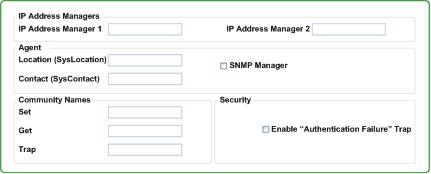|
SNMP Configuration
|
|
|
Original instructions
|

|
Property
|
Description
|
|---|---|
|
IP address managers:
|
|
|
IP address manager 1
|
The IP address of the first SNMP manager to which the SNMP agent sends notices of traps.
|
|
IP address manager 2
|
The IP address of the second SNMP manager to which the SNMP agent sends notices of traps.
|
|
Agent:
|
|
|
Location
|
The device location (32 characters maximum)
|
|
Contact
|
Information describing the person to contact for device maintenance (32 characters maximum).
|
|
SNMP manager
|
When this checkbox is:
Default = de-selected.
|
|
Community names:
|
|
|
Get
|
Password required by the SNMP agent before executing read commands from an SNMP manager. 16 characters maximum. Default = public.
|
|
Set
|
Password required by the SNMP agent before executing write commands from an SNMP manager. 16 characters maximum. Default = private
|
|
Trap
|
Password an SNMP manager requires from the SNMP agent before the manager will accept trap notices from the agent. 16 characters maximum. Default = alert
NOTE:
|
|
Security:
|
|
|
Enable “Authentication Failure” trap
|
If an unauthorized manager sends a Get or Set command to the SNMP agent, the agent sends a trap notification message to the manager. Default = de-selected.
|